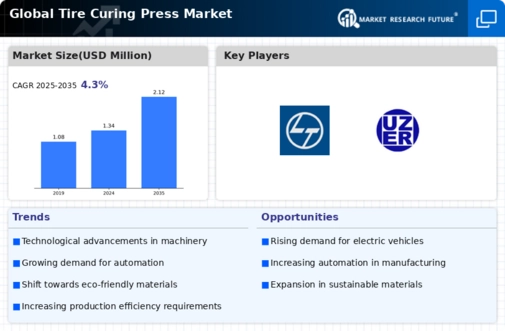Tire Curing Press Size
Tire Curing Press Market Growth Projections and Opportunities
In recent years, the global tire curing press market has experienced noteworthy growth, propelled by the expansion of the automotive industry and the rising global demand for high-performance tires. At the heart of tire manufacturing processes, the tire curing press plays a pivotal role in shaping and vulcanizing tires, imparting them with their final form, strength, and durability. The trajectory of the global tire curing press market indicates substantial growth in the foreseeable future, driven by factors such as increased transportation activities, technological advancements, and the imperative for efficient and sustainable solutions.
The market segmentation is structured based on type, mold, and application. In terms of type, the global tire curing press market distinguishes between mechanical, hydraulic, and hybrid variants. As of 2022, the mechanical segment is poised to lead the market, holding a significant share valued at USD 585.7 million. Projections suggest that this segment will exhibit the highest Compound Annual Growth Rate (CAGR) of 3.7% within the Type category during the forecast period.
The segmentation based on mold categorizes the market into two-piece mold and segmental mold. In the year 2022, the two-piece mold segment has taken the lead, securing substantial market shares. This segment is anticipated to present a noteworthy incremental opportunity of USD 228.5 million over the forecast period.
Application-wise, the market is classified into Passenger Car Radial (PCR), Truck and Bus Radial (TBR), 3-wheeler, and 2-wheeler segments. The PCR segment is expected to spearhead the global tire curing press market throughout the forecast period, projecting a total incremental opportunity of USD 197.1 million by the end of 2030.
In conclusion, the global tire curing press market is on an upward trajectory, fueled by the robust growth of the automotive sector and the increasing demand for top-notch tires worldwide. The pivotal role of tire curing presses in shaping and enhancing tire characteristics positions them as indispensable components in the tire manufacturing process. With distinct segments based on type, mold, and application, the market showcases a dynamic landscape poised for substantial growth. The mechanical type, two-piece mold, and PCR application segments are particularly noteworthy, with promising market shares and growth prospects. As transportation activities surge and technology advances, the tire curing press market is poised to remain a key player in delivering efficient and sustainable solutions to meet global demands.







Leave a Comment